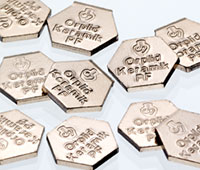
Orplid Keramik PF
Type 4
pale yellow / Au 77.7
palladium-free, silver-free, copper-free
| Composition: | Au 77.7 / Pt 19.5 / Zn 2.0 / Ta 0.7 / Ir 0.1 |
| Standard: | DIN EN ISO 22674 and DIN EN ISO 9693 |
| Colour: | pale yellow |
| Melting range °C: | 1165–1050 |
| Soft annealing: | 15 mins at 900 °C / quench in water |
| Hardening: | 15 mins at 550 °C/ air |
| Preheating temperature °C: | 800 |
| Casting temperature °C: | 1320 |
| Further heating after melting (secs): | electr.: 90–120 inductive: 5–10 flame: 5–10 |
| Density g/cm3: | 19.1 |
| CTE 25°C–500°C (µm/mK): | 14.0 |
| CTE 25°C–600°C (µm/mK): | 14.1 |
| Soldering before firing: | Orplid Ceramic solder 1050 |
| Soldering after firing: | Orplid solders 760, 735 |
| Vickers hardness (HV 5/30): | w: 110 a: 220 g/b: 220/260 |
| 0.2% proof stress (MPa): | w: 260 a: 410 g/b: 460/550 |
| Elongation at break (%): | w: 23 a: 15 g/b: 11/10 |
| Spruing: | Following the rules for dental applications (see General Instructions for Use) |
| Investment: | Phosphate-bonded investment materials |
| Preheating: | 850 °C, 30 to 120 mins until end temperature, depending on size of mould |
| Casting: | 1320 °C, possibly increase by 20°C–30°C for resistance-heated vacuum pressure casting. Graphite crucible or open flame with ceramic crucible |
| Finishing: | With carbide burs and/or ceramic-bonded stones. Always grind in one direction only! Sandblasting at a flat angle, using 50–125 µm aluminium oxide. Pressure should not exceed 2 bar |
| Cleaning: | Steam jet cleaning or boiling in distilled water |
| Oxide firing: | 5 mins at 940°C without vacuum. Afterwards, always clean in a preheated acid bath, e.g. Neacid, (for 10 mins) or sandblast with 50–125 µm aluminium oxide. Pressure should not exceed 2 bar. Clean thoroughly with a steam jet |
| Soldering before firing: | Orplid Ceramic solder 1050 |
| Soldering after firing: | Orplid solder 760; Orplid solder 735 |
| Firing: | For normally expanding ceramic materials |
